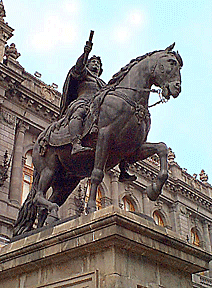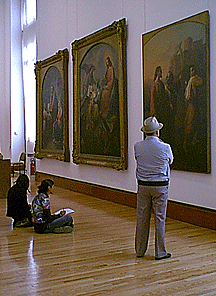 For
almost 20 years I’ve had an affair with a vivacious, sometimes
naughty, effervescent, and artistic woman. People have told me that I
should live with her, but I can’t, for she’s a city–Mexico City,
to be exact. Here, spreading for miles on an old lake bed is a
metropolis so filled with art that it has taken me this long to see most
of it, but not all. For
almost 20 years I’ve had an affair with a vivacious, sometimes
naughty, effervescent, and artistic woman. People have told me that I
should live with her, but I can’t, for she’s a city–Mexico City,
to be exact. Here, spreading for miles on an old lake bed is a
metropolis so filled with art that it has taken me this long to see most
of it, but not all.
Out of all the art
museums in Mexico City–some 30 of them, 25 percent of the total–I
chose the Anahuacalli Museum, probably the most bizarre, hardest to
find, and loneliest in the city to visit first. Even my taxi driver had
to stop and ask for directions. But as he pulled up in front of what
looked like a stylized Aztec pyramid, I felt that I had discovered
something that few tourists ever see.
Annahuacali Museum
Mexican muralist Diego Rivera designed Anahuacalli, which means
"the house of the land by the lake," to awe the visitor–and
he succeeded on a grand scale. I imagine the lake in this case refers to
the dried up lake bed on which the museum stands. This pyramid-like
structure, built of reinforced concrete faced with pedregal, a
type of volcanic rock, contains over 60,000 artifacts from this Zapotec,
Toltec, Teotihuacan, Vercruz, Mixtec, Aztec cultures–the largest
private collection displayed in Mexico. His friend and fellow artist and
architect, Juan O’Gorman, built the eerie and mystical museum hidden
away in the southern part of Mexico City. Construction began in 1933 and
was completed in 1963, six years after Rivera's death.
In front of the museum is
a reproduction of a Toltec ball court, and the entrance to the museum is
a coffin-shaped door. Light filters in through translucent onyx slabs,
supplemented by lights inside niches and wall cases containing the
exhibits. Twenty-three display rooms, many with mosaic ceilings
depicting dueling serpents and other pre-Hispanic symbols, are arranged
in chronological order, with thousands of the pieces stashed on the
shelves, tucked away in corners, and peeking out of glass cases.
The upstairs studio
opened Rivera's life to my inquisitive eyes, revealing some of his
personal belongings and sketches, some incomplete as if waiting his
return. I saw the original sketches for some of his murals and two
in-progress canvases. There's a photo of his first sketch of a train,
done at the age of three, plus a color photograph of him at work later
in life. A plaque in the museum proclaims him "a man of genius who
is among the greatest painters of all time."
MUNAL
 Back in the Centro Historico, the city’s heart, stands the Museo
Nacional de Arte MUNAL–the National Arts Museum–housed in the former
Palacio de Comunicaciones on the north side of Calle Tacuba, a couple
blocks down from Alameda Park and probably one of the best art museums
in the city. Italian architect Silvio Contri completed the reserved,
gray palace in 1910, but it wasn’t converted to a museum until1982. I
wandered through its 22 newly renovated galleries filled with Mexican
art from the colonial era through the 20th Century. I
discovered paintings by Colonial painters Miguel Cabrera, Cristobal
Villalpando, and Luis Juarez showing the conquest of Mexico,
romantic19th-century canvases by painters Juan Cordero, Jose Maria
Velasco, and Ramon Sagredo and 20th-century masterpieces by
artists such Diego Rivera, Frida Kahlo, Rufino Tamayo and others, plus
lifesize marble sculptures of Moctezuma, Malinche, and Cortes.
Back in the Centro Historico, the city’s heart, stands the Museo
Nacional de Arte MUNAL–the National Arts Museum–housed in the former
Palacio de Comunicaciones on the north side of Calle Tacuba, a couple
blocks down from Alameda Park and probably one of the best art museums
in the city. Italian architect Silvio Contri completed the reserved,
gray palace in 1910, but it wasn’t converted to a museum until1982. I
wandered through its 22 newly renovated galleries filled with Mexican
art from the colonial era through the 20th Century. I
discovered paintings by Colonial painters Miguel Cabrera, Cristobal
Villalpando, and Luis Juarez showing the conquest of Mexico,
romantic19th-century canvases by painters Juan Cordero, Jose Maria
Velasco, and Ramon Sagredo and 20th-century masterpieces by
artists such Diego Rivera, Frida Kahlo, Rufino Tamayo and others, plus
lifesize marble sculptures of Moctezuma, Malinche, and Cortes.
Belles Artes
Less than two blocks from the National Arts Museum, the huge domed
Palacio de Bellas Artes, or Palace of Fine Arts, Mexico City’s
magnificent opera house, built of Carrara marble and home to the
National Folkloric Ballet, loomed into view. This architectural
masterpiece combines Art Deco design and murals by some of Mexico’s
foremost painters–Rivera, Orozco, Siqueiros, Tamoyo, O’Gorman–with
the opulence of a Art Nouveau facade. Construction began in 1904, during
the presidency of Porfirio Diaz, under the supervision of Italian
architect Adamo Boari. He had planned for the building to be a
masterpiece of art nouveau architecture but, frustrated by interruptions
wrought by the decade-long Mexican Revolution, he left Mexico in 1916
having completed only the exterior with decoration that mixed classical
Greco-Roman statuary with Aztec motifs such as serpent heads and
representations of Aztec warriors, most of it sculpted by Italian
artists.
One of Boari's Mexican
apprentices, Federico Morris Cowell, took over the design in 1932 and
finished the interior of the building as well as the impressive cupolas
in the Art Deco style. For the main auditorium inside, Mexican painter
Gerardo Murillo designed a huge stained-glass stage curtain–Cortina
de cristal–depicting the volcanoes of Popocatepetl and
Ixtaccihuatl, which Tiffany Studios of New York assembled from over one
million pieces of glass.
Though the building’s
exterior had suffered from severe air pollution, especially the
copper-laminated cupolas considered to be the best examples of Art Deco
in Mexico, it has been magnificently restored to it former grandeur.
Inside, I paused in the large mezzanine to look up at the light
streaming in from the Palace’s three cupolas. The massive marble
building is so heavy that it has already settled nearly 15 feet into the
old lake bed.
Climbing the massive
stairway to the second floor, I came upon one of the Palace’s
highlights, a vast mural entitled "Nueva Democracia" painted
in 1944 by Mexico's most famous muralist, David Alfaro Siqueiros.
Siqueiros' wife served as a model for the bare breasted helmeted woman
breaking out of chains in the mural. For this painting, the central
panel of a larger triptych, Siqueiros used pyroxilin, a commercial
enamel used for airplanes and automobiles. Diego Rivera's 1934 mural
"El hombre Contralor del Universo" or Man, Controller of the
Universe, occupies another wall. On the south wall, Jose Clemente Orozco
1934-35 La Katharsis depicts a confrontation of the mechanistic world
with humanity in a swirl of guns, machines, and tortured human faces.
Murals by other Mexican artists line the remaining walls.
Pinacoteca Virreinal de
San Diego
After strolling through the Alemada, with its sparkling fountains and
lovers holding hands on iron benches, I came upon the Pinacoteca
Virreinal de San Diego, which houses one of the finest collections of
Colonial religious paintings in the Americas. The former church and
Chapel Annex of the Convento de San Diego, first constructed during the
first half of the 17th century by the Franciscans, displays works of art
contained rescued from monasteries and churches that closed during
19th-century secularization. Most of the paintings, usually oil on wood
or oil on canvas, were originally created for retablos, the
elaborate gilded altarpieces common to colonial churches, so they're
large. Arranged along the walls of the former church's single octagonal
nave and in an attached cloister, the 16th- and 17th- century works
blend Spanish, Italian, and Flemish influences to produce a truly
Mexican school of religious painting. As I gazed at the Chapel's
striking blue and gilt ceiling, I marveled at the workmanship
Rivera Mural Museum
Not far from the Pinacoteca Virreinal de San Diego is a small museum
containing the original of Diego Rivera’s most famous mural, "Sueno
de Una Tarde Dominical en la Alameda Central" or "Dream of a
Sunday Afternoon in Alameda Park," originally painted in 1947 on a
wall in the Del Prado Hotel which was destroyed in the 1985 earthquake.
Miraculously, the mural sustained only minor damage and was then
relocated across The Reforma in a specially designed building on a side
of Jardin de la Solidaridad or Solidarity Garden, a tiny square,
dedicated to the memory of all those who lost their lives in the quake,
built on the former site of the Hotel Regis, also destroyed during the
quake.
Dominating the museum's
back wall, the 49 by 13 foot mural’s park scene portrays many famous
Mexican personalities, including Hernan Cortez, Porfirio Diaz, Francisco
I. Madero, Emperor Maximilian and his wife Carlotta, and General Antonio
Lopez de Santa Anna–handing the keys to Mexico to American General
Winfield Scott. Standing to the right of center of the cartoon-like
mural is Frida Kahlo, holding her left-handed Taoist yang gang symbol. A
self-portrait of Diego Rivera as a young boy stands in front of her.
Franz Mayer Museum
Mexican friends told me not to miss the Franz Mayer Museum, which
displays thousands of Mexican antiques. So on another visit to the area
around the Alameda, I wandered into this beautifully restored 16th-century
building which had been used as a women’s hospital in the 18th
Century. Today, it houses a collection of European, American and Asiatic
art objects accumulated by the German-born, financier-philanthropist
Franz Mayer and donated to the people of Mexico.
Located on the northwest
corner of the Plaza de la Veracruz, the fine collection, which covers
two floors, includes 16th through 19th-century Mexican
ceramics, antique rebozos or Mexican shawls, religious articles,
furniture, textiles, silver and gold pieces, clocks and even full cocina
poblanas or tile Puebla-styled kitchens. I found the museum’s
quiet courtyard café towards the back an excellent spot to relax and
reflect on the beauty around me.
Museums to Frida Kahlo
On subsequent trips to Mexico City–sometimes long and other times
short–I visited other museums as time allowed. Of course, I had to
visit the mecca of Fridaholics, Casa Azul, Frida Kahlo’s house in
Coyoacan, but even more impressive is the Dolores Olmedo Patiño Museum
in the southern suburb of Xochimilco. Here I discovered the largest and
best collection of Kahlo’s work, housed in the restored 17th-century
Hacienda La Noria. And, like the Anahuacalli, a bit hard to find. This
is the setting for Olmedo’s rotating collection of more than 600
pre-Hispanic artifacts and pieces of native art, plus 127 pieces by
Diego Rivera and 25 by Kahlo.
A lifelong friend of
Rivera, Olmedo became the trustee of much of Rivera's work as well as
the art of two of his former wives–Kahlo and Russian artist Angelina
Beloff. One of the rooms contained Rivera's painting, "In the
Fountain of Toledo," another portraits of Olmedo and his 1956
series of sunsets from her home in Acapulco. But the rooms full of art
are only half of the beauty of this place. The hacienda’s grounds,
encompassing nearly 10 acres of beautifully landscaped gardens, are
alive with strutting peacocks, as well as several Xoloitzcuintle dogs, a
rare pre-Cortesian canine species that are small dark and hairless.
And so I’ll continue my
quest to visit more of Mexico City’s art museums–Museo de Arte
Internacional Rufino Tamayo, Museo de Arte Carrillo Gil, Museo de Arte
Moderno, Museo San Carlos–the list goes on and on.
|
